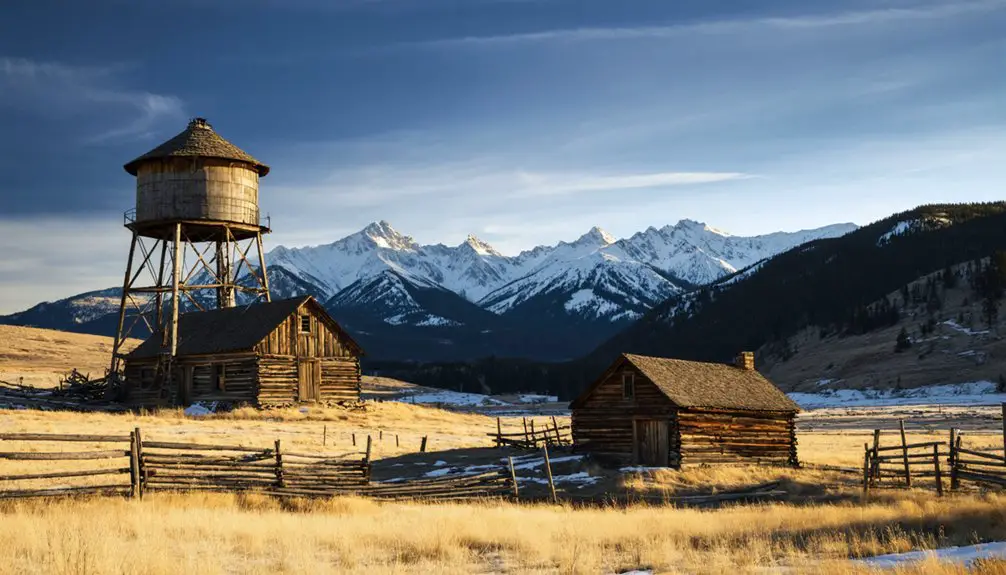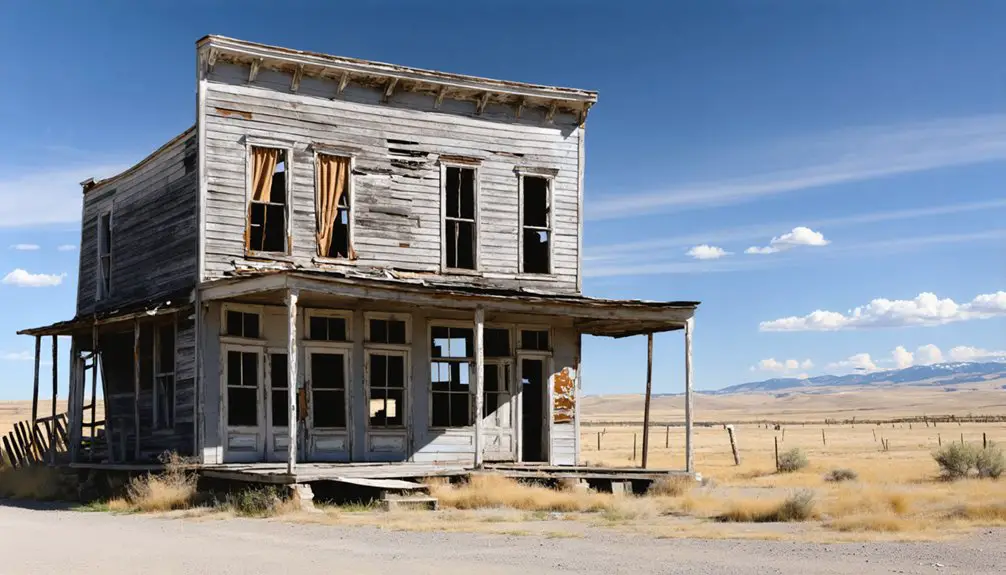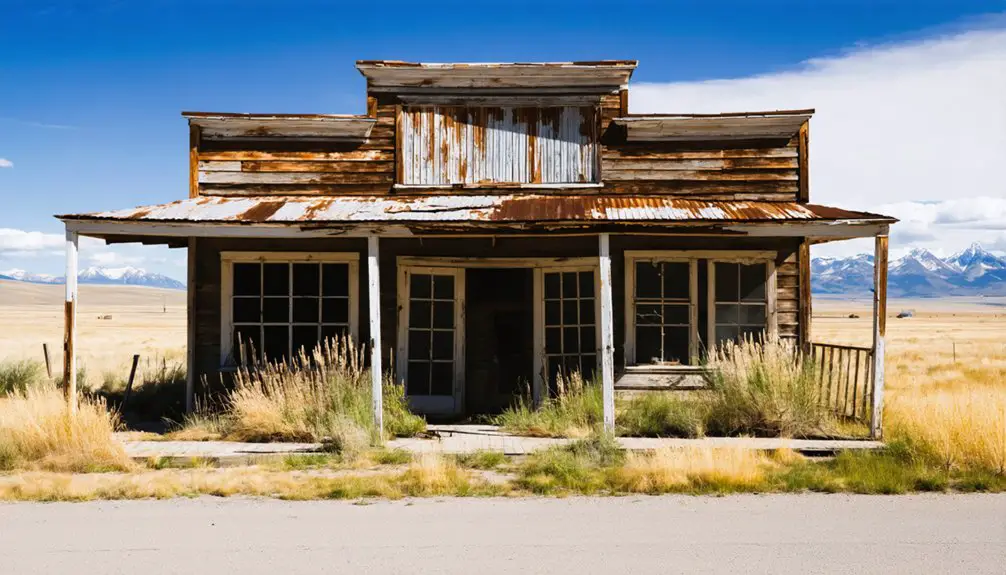You’ll find Cable’s ghost town remnants in southwestern Montana, where prospectors struck gold in 1867 at the Atlantic Cable Lode. The site thrived with a sprawling gold-bearing quartz deposit stretching 1,800 feet, supporting multiple mills and a diverse mining community until 1940. Through harsh winters and ownership disputes, miners extracted visible gold flakes from the metamorphic ore deposits. The town’s silent ruins and abandoned mines hold countless stories of Montana’s golden era.
Key Takeaways
- Cable began as a mining settlement in 1867 with the discovery of the Atlantic Cable Lode, producing significant gold from contact metamorphic deposits.
- The town thrived through early mining operations but faced ownership disputes, leading to sporadic activity and eventual decline by the late 1800s.
- A devastating fire in 1905 destroyed the business district, marking a crucial turning point in the town’s decline toward ghost town status.
- The Gold Coin Mill’s closure in 1940 marked the final end of mining operations and led to complete abandonment of Cable.
- Miners endured harsh winter conditions, requiring extensive preparation and survival skills while working the mines in isolated mountain terrain.
The Discovery of Cable’s Gold Deposits
While prospectors were camping in the Cable area during 1867, their missing horses led to an unexpected discovery that would change the region’s future.
During their search, they stumbled upon a massive quartz pillar loaded with gold – a find that would become known as the Atlantic Cable Lode.
Similar to how Confederate Gulch yielded significant gold deposits in 1864, this discovery marked another important mining site in Montana’s territory.
You’ll find this discovery wasn’t your typical gold rush strike; it was a unique contact metamorphic deposit where granite intrusions had transformed limestone into rich gold-bearing ore.
The deposit stretched an impressive 1,800 feet, featuring high-grade zones with visible gold flakes alongside tetradymite and calcite.
Lower-grade sections contained pyrite and pyrrhotite.
The mineral deposits formed part of Montana’s evolving mining story, marking a shift from placer mining to more complex geological exploration.
The area eventually became private property, restricting access to these historic geological formations.
Early Mining Operations and Development
Following the 1867 discovery of the Atlantic Cable Lode, a trio of prospectors staked their initial claims and secured financial backing from Helena investors to begin mining operations.
You’ll find that early development moved swiftly with the construction of basic mining infrastructure, though internal disputes among the original miners soon emerged. The mining landscape in Montana had already seen success after gold was discovered near Deer Lodge in the 1850s.
These conflicts ultimately forced the sale of the property within a decade, setting a pattern of ownership changes that would characterize Cable’s mining history. By 1867, they had constructed a mill on site, marking one of their first major infrastructure developments.
Discovery and Initial Claims
In 1867, three prospectors established Cable’s mining camp after discovering a massive quartz pillar rich in gold, which they named the Atlantic Cable Lode in honor of the newly-laid transatlantic telegraph cable.
This remarkable discovery came about through an unexpected turn of events – their horses were stolen on the first night, and while searching for the missing animals, they stumbled upon the gold-rich quartz vein.
You’ll find that these early prospector stories exemplify the pioneering spirit of Montana’s mining era.
The initial claims focused on quartz mining, requiring substantial effort to extract the precious metal from the rock.
Like many other abandoned mining camps across Montana, disputes among the original miners led to sporadic operations, eventually forcing a halt around 1877.
Early mining efforts utilized common extraction methods like panning and sluicing to separate gold from surrounding materials.
While the discovery attracted Helena’s wealthy investors who helped develop the necessary infrastructure, disputes among the original miners led to sporadic operations, eventually forcing a halt around 1877.
Financing and Early Disputes
Despite initial financial backing from Helena’s wealthy investors in the late 1860s, the Atlantic Cable Lode faced significant operational challenges due to ownership disputes among the original prospectors.
Similar to other Montana mining districts where local governance facilitated operations, the lack of clear oversight and established regulations contributed to the property disputes at Cable.
You’ll find that these ownership conflicts severely impacted the mine’s development, leading to intermittent operations and eventual sale of the property in the early 1880s.
While the capital helped establish basic mining infrastructure and formalize claims, investment challenges persisted throughout the mine’s history.
The construction of the Gold Coin Mill in 1906 marked a significant upgrade, but the mine’s remote location and transportation costs continued to limit profitability.
Even after railroad connections improved in the 1880s, the combination of unstable financing and management issues led to sporadic operations until the mine’s final closure in 1940.
The Rise of the Gold Coin Lode
While Cable’s mining history began with the Atlantic Cable Lode in 1867, the discovery of the Gold Coin Lode in 1898 brought new life to the area. The new gold mining venture produced $200,000 in gold over the next decade, making a significant economic impact on the region. The area’s rich mineral deposits were part of the Georgetown District’s output, which yielded approximately 460,000 ounces of gold.
Though Cable’s mining fortunes began with Atlantic Cable in 1867, the Gold Coin Lode discovery in 1898 revitalized the region’s economy.
You’ll find the deposit nestled in Meagher limestone, stretching 1,800 feet long and up to 360 feet wide.
- High-grade ore contained visible flake gold and tetradymite in calcite
- Construction of the Gold Coin Mill in 1906 marked sustained operations
- The ore body included copper and magnetite deposits
- Low-grade ore featured pyrite and pyrrhotite with dolomite
- Mining operations continued sporadically until 1940
The Gold Coin Lode contributed to Montana’s impressive total gold output, which reached over 19 million ounces by the late 20th century.
Life in a Montana Mining Camp
You’d find a typical day in Cable’s mining camp filled with backbreaking ore extraction from sunup to sundown, followed by evenings where miners sought refuge in the camp’s social venues like saloons and dance halls.
When winter descended on the remote settlement, you’d join other residents in stockpiling supplies and reinforcing shelters against Montana’s brutal mountain storms. A diverse mix of ex-Confederate soldiers and other fortune seekers worked side by side in the mines, putting aside their differences in pursuit of gold.
Despite the harsh conditions, you’d witness how the community pulled together, sharing resources and maintaining social bonds through organized entertainment and gatherings at the local establishments. The miners endured brutal working conditions while pursuing wealth in the rich mineral deposits of the region.
Daily Mining Camp Routines
Life in a Montana mining camp revolved around the demanding routines of ore extraction and survival.
You’d spend your days following strict daily tasks, from “barring down” loose rock after blasts to maintaining critical tunnel supports. Mining wasn’t just about digging – it meant constantly evaluating rock stability through sound tests and working as a team to process valuable ore.
- You’d start at dawn, checking equipment and testing for dangerous loose rock zones.
- Physical labor dominated your day with tunneling, rock breaking, and ore transport.
- Team coordination was essential for sharing technical tasks and excavation work.
- Equipment maintenance and ore processing filled any remaining daylight hours.
- Winter weather could force you to suspend operations or relocate to lower elevations.
Social Life After Dark
After grueling shifts in the mines, Montana’s mining camps transformed into vibrant social hubs where workers sought escape and entertainment.
You’d find saloons buzzing 24 hours a day, with pianos playing and miners drinking away their hardships. The nightlife culture revolved around these establishments, where you could join card games, listen to live music, or share stories with fellow workers.
The social escapism wasn’t limited to saloons – you could attend events at community halls, watch theater performances, or participate in informal competitions under the stars.
Mining companies actually encouraged these activities, keeping workers spending locally rather than saving to leave town. While the atmosphere could turn rowdy and occasionally violent, these social spaces provided essential relief from the demanding physical labor of mining life.
Survival Through Harsh Winters
While summer months brought their own challenges to Montana’s mining camps, winter transformed survival into a daily battle against nature’s harshest elements.
You’d face subzero temperatures, heavy snowfall, and treacherous ice that turned simple tasks into life-threatening ordeals. Winter survival meant fortifying your cabin with local timber, stockpiling months of preserved food, and maintaining constant vigilance against the deadly cold.
- You couldn’t count on resupply runs during months of blocked mountain passes
- Your cabin’s fireplace became your lifeline, requiring endless fuel gathering
- You’d need to master snow melting for water and careful food rationing
- Isolation challenges meant developing self-reliant survival skills
- A single mistake in preparation could prove fatal until spring thaw
These harsh conditions forged tough, resourceful miners who learned to embrace independence while respecting winter’s unforgiving power.
Mining Technology and Methods
Throughout Cable’s mining heyday, operations relied heavily on manual labor and basic extraction methods before modernization gradually took hold.
You’d find miners working discovery shafts at least 10 feet deep, using hand drills and black powder blasting to break through rock. The ore processing techniques remained primitive at first, with arrastra mills where horses dragged heavy stones to crush ore before mercury amalgamation separated the precious metals.
As mining equipment advancements reached Cable, steam-powered crusher rollers and stamps improved efficiency.
Headframes supported the movement of skips and cages, while underground operations expanded with better hoisting systems.
You’d see crews swapping out these skips between shifts, managing the constant flow of ore from deep within the earth to the surface processing facilities.
Geographic Location and Natural Setting

Nestled in southwestern Montana‘s rugged terrain, Cable ghost town sits between Drummond and Anaconda, just north of Silver Lake along the Pintler Scenic Route in Deer Lodge County.
The mining geography showcases rich quartz pillars and gold-bearing lodes, surrounded by mountainous landscapes typical of the region. You’ll find yourself at elevations between 4,000 and 6,000 feet, where the continental climate brings cold winters and mild summers.
- Ancient volcanic activity shaped the dramatic mountain ranges and exposed mineral veins
- Abundant natural resources, including timber and water from nearby streams
- Rich quartz deposits and the famous Atlantic Cable Lode drew prospectors
- Seasonal snowfall impacts accessibility during winter months
- Surrounding forests provided essential materials for mine construction and fuel
Economic Legacy and Production Records
The Cable Mine’s economic impact emerged from its rich deposits of gold, silver, tungsten, and copper, creating a mining legacy that spanned from 1866 through 1957.
You’ll find evidence of its remarkable revenue generation in the production records, which show silver concentrations reaching up to 750 ounces per ton in nearby veins. The operation exceeded $1 million in value during its prime, with high-grade silver ore shipments ranging from 25 to 100 ounces per ton.
Canyon Lode Mining Co., based in Anaconda, managed the underground operations that employed crews of 4 to 10 miners. The five-stamp mill and electric power from Flint Creek supported the mine’s productivity, while market fluctuations and wartime constraints shaped its economic trajectory.
Decline and Abandonment

Despite its early promise, Cable’s mining operations began their decline shortly after the first decade, marked by bitter disputes among original miners that forced operations to halt in the late 1870s.
The town’s economic decline accelerated through multiple failed revival attempts, culminating in a devastating 1905 fire that destroyed the business district.
A series of economic setbacks and failed revivals led to Cable’s downfall, with the 1905 fire delivering a crushing blow.
You’ll find that each setback triggered further population exodus, until the final closure of the Gold Coin Mill in 1940 sealed the town’s fate.
- Mining operations struggled through sporadic reopenings between 1883-1891
- Gold Coin Lode discovery in 1898 provided brief revival
- Fire of 1905 destroyed crucial business infrastructure
- Limited rebuilding efforts hastened community dissolution
- By 1940, complete abandonment followed mine and mill closure
What Remains Today
Modern visitors to Cable’s former site will find little evidence of its once-bustling mining operations. The historical significance of this Montana ghost town has largely faded from view, with most structures, including the Gold Coin Mine and Mill, now demolished or deteriorated beyond recognition.
Unlike other preserved ghost towns in the state, you won’t find intact buildings, mining equipment, or interpretive displays at Cable.
The site’s preservation challenges stem primarily from its private ownership status, which restricts public access and prevents conservation efforts. What remains are mostly scattered debris and building foundations where structures once stood.
While ghost towns like Garnet and Granite maintain visible links to Montana’s mining past through standing structures and artifacts, Cable’s physical remnants have virtually disappeared from the landscape.
Frequently Asked Questions
Were There Any Notable Crimes or Lawlessness Reported in Cable’s History?
You won’t find documented crime incidents specific to Cable in historical records, though the area lacked formal law enforcement and likely experienced typical frontier-era lawlessness common to Montana mining communities.
What Was the Total Population of Cable During Its Peak Mining Years?
Like finding a needle in a haystack, you won’t find exact population figures. During the mining boom, Cable’s population likely peaked at several hundred residents before experiencing population decline in the late 1800s.
Did Any Famous Historical Figures Ever Visit or Invest in Cable?
You won’t find any famous visitors or historically notable figures who invested in Cable. Local Helena financiers backed the mining operations, but there’s no documented evidence of celebrity involvement or prominent personalities.
Were There Any Schools or Churches Established in Cable During Its Existence?
Through the dust of time, you won’t find concrete evidence of schools or churches in Cable. While nearby mining towns had these institutions, historical records don’t confirm any educational or religious establishments here.
What Happened to the Families and Miners After Cable’s Final Closure?
You’ll find mining families scattered after 1940, relocating to larger towns for work when Cable became a ghost town. They sought jobs in other mining districts or different industries during wartime.
References
- https://www.legendsofamerica.com/cable-montana/
- https://destinationmissoula.org/ghost-towns
- https://www.garnetghosttown.org/history.php
- https://www.youtube.com/watch?v=YU0y9_5Ylbg
- https://www.legendsofamerica.com/mt-ghosttowns/
- https://www.clengpeerson.no/gold-discovery-established-meagher/
- https://archiveswest.orbiscascade.org/ark:/80444/xv28731
- https://montana-gold.blogspot.com/2010/02/gold-deposits-of-montana.html
- https://westernmininghistory.com/10183/principal-gold-districts-of-montana/
- https://westernmininghistory.com/mine-detail/10069752/



